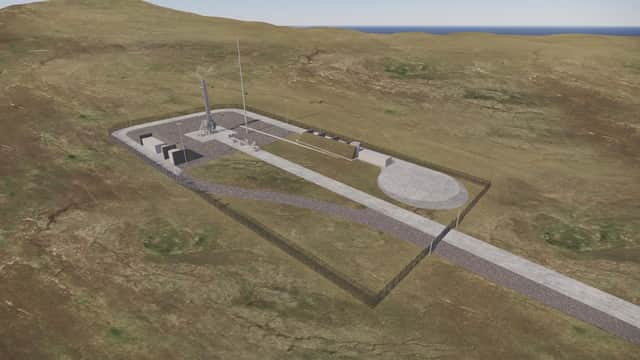Tha cothroman mora a’ tighinn le obair fànais, ach tha cunnart ann gun tig an call


[English-language version below]
’S dòcha nach bi e idir mar a bhios sinn a’ coimhead anns na filmichean saidheans-ficsein, ach tha leasachaidhean ùra an ìmpis tachairt nuair a thig e gu bhith a’ cur rocaidean suas dha na speuran, le Alba air thoiseach air càch. Uill, ’s dòcha…
’S e an t-amas an-dràsta làraichean fhaighinn a bhios freagarrach nan rocaidean a chur suas agus feumaidh iad a bhith meadhanach iomallach.
Advertisement
Hide AdAdvertisement
Hide AdSon a bhith cothromach mu dheidhinn, bu chòir coimeas eadar leithid Nasa agus rudan dhen t-seòrsa sin a chur às ar n-inntinn. Chan eil na rocaidean a tha sinn a’ bruidhinn mu dheidhinn an seo gu bhith ach beag, a’ giùlain saidealan anns nach bi ach mu 100kg de chuideam.
Ach, tha an cothrom fhathast mòr gu leòr airson aire Iomairt na Gàidhealtachd is nan Eilean a ghluasad agus e mar phrìomh amas aca airson eaconamaidh na sgìre.
Thòisich obair togail air làrach ann an Cataibh na bu thràithe am-bliadhna agus ‘s e a’ chiad àite ann am Breatainn far an tèid rocaidean a chur suas dha na speuran. Tha làraich eile san amharc ann an Sealltainn, Uibhist-a-Tuath is Machair Shanais.
Chan eil e gun chonnspaid ged-tà, le mòran a’ smaoineachadh gu bheil na h-ionadan mì-fhreagarrach airson sgìrean àlainn an tuath.
Chuir an t-uachdaran Anders Povlsen an aghaidh nam planaichean ann an Cataibh gu laghail agus tha ath-chuinge a-nis air a chur air dòigh airson feuchainn ri stad na tha tachairt ann an Uibhist-a-Tuath.
Tha HIE dhen bheachd gun cruthaich am pròiseact ann an Cataibh obair dha 100 neach air an làrach fhèin agus 400 neach eile agus. S e àireamh mhòr a tha sin ann an àite far a bheil cion obraichean.
A’ bruidhinn aig Comataidh nan Cùisean Albannach aig Westminster, thuirt Dùghlas Liddle, iar-chathraiche Buidheann Fànais Bhreatainn: “Tha tòrr a’ tachairt a-thaobh an teicneòlais ann a bhith cruinneachadh fiosrachadh agus na gheibh thu air a dhèanamh le dealbhan.
“Tha tòrr de rudan dol a thighinn am bàrr anns na còig agus deich bliadhna air thoiseach, bho bhith tuigse na tha tachairt le càrbon agus truailleadh, gu tuigse na tha tachairt le craobhan is crìonadh nan cladaichean, gu truailleadh na mara.
Advertisement
Hide AdAdvertisement
Hide Ad“’S urrainn dhut sùil a chumail air a h-uile càil a tha sin bho na speuran. Mar is àbhaist feumadh cuideigin a dhol a-mach air an t-sitig le camara is maidean tomhais, ach le saideal gheibh thu air an obair sin a dhèanamh gu math nas fhasa.”
Ach, thuirt e: “’S e an duilgheadas, ma gheibh thu air a dhèanamh ann an Alba, gheibh thu air a dhèanamh ann an Singapore cuideachd.”
Agus sin far a bheil an cunnart, mòr ’s gu bheil an cothrom.
English-language version:
Space, the final frontier… a prospect and concept I suspect that’s impenetrable to most of us, but where new economic opportunities lie, and not in some far off galaxy either, but right here in our own communities. It may not be exactly as imagined by the science fiction writers of yesteryear, but a new front is about to open up on sending satellite-carrying rockets into Earth’s near orbit, a mini space race in which Scotland stands ready to take a lead. Perhaps…
The focus right now is on developing suitable launch sites which by their very nature need to be fairly remote and underneath relatively undisturbed air space. Step forward the Highlands and Islands as it bids to become the UK’s version of Cape Canaveral. Well, maybe not quite, as in all fairness, comparisons with Nasa and the big space programmes should be steadfastly avoided because what’s in store here in Scotland bears little resemblance, both in scope and ambition, with the rockets envisaged set to carry payloads of just 100-200kg, effectively mini-satellites for communications and research work.
But the opportunity is still enough to persuade the economic agency Highlands and Islands Enterprise to focus much of its attention on the sector, with a location in the north-west of Sutherland set to become the UK's first vertical launch spaceport. Construction started last May with an investment of £14 million. Other sites are planned for Shetland, North Uist and Machrihanish.
As might be expected, it’s not without controversy, as there are those who believe that such projects will be a scar on unspoilt wildernesses. The billionaire Danish landowner and self-styled environmentalist Anders Povlsen, who owns an estate near the Sutherland site, launched an unsuccessful legal challenge and a Scottish Parliament petition has just been lodged by campaigners fighting the plans in North Uist.
HIE say that the Sutherland project alone could support a workforce of 100 directly and 400 indirectly and, even treated with a degree of caution, that's a significant contribution in communities where employment is scarce. Doug Liddle, vice-chair of UKspace, told the Scottish Affairs Committee on Monday that the genesis of a new space industry already exists in Scotland, but there needs to be more public awareness and support, or there is a risk of being left behind.
“There is a lot of stuff around Earth observation data and imagery,” he told an evidence session of the committee. “A number of services will be coming online over the next five or ten years – everything from understanding what is going on with carbon and greenhouse gas emissions, to understanding what is happening with forestry and coastal erosion, and the monitoring of algal blooms.
“Those are all things that you can do very simply and quickly from space. This would normally involve people going out into the field with cameras and sticks and putting them in the water, but those jobs suddenly become much simpler with a satellite.”
However, he warned: “The difficulty is if you can do it in Scotland, you can do it in Singapore.”
Comments
Want to join the conversation? Please or to comment on this article.